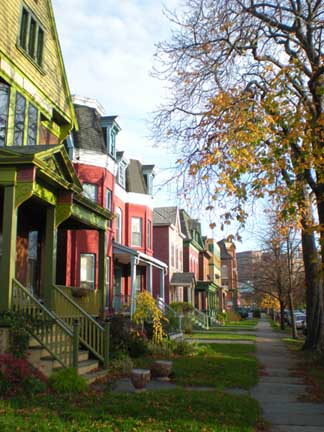The
West Village, according
to the community’s 1980 application for the National Register of
Historic Places, “is one of Buffalo's oldest and most intact
residential areas. Its tree-lined streets, slate sidewalks and stone
carriage steps help create a distinct flavor for this section of the
city.”
Located on the city’s Lower West Side, it is bounded on the east by
South Elmwood, on the north by Tracy Street, on the northwest by
Carolina Street and on the southwest by Niagara and Huron streets.
For the most part, homes on the west side of Prospect were built
earlier than those on the street’s east side. Development began when
Silas H. Fish purchased the lot at the corner of Prospect and Georgia
streets in 1866 for the construction of Buffalo’s first Baptist
church. Known then as the Ninth Street Baptist Church, it was in
operation by 1868 and, in time, would come to be known as the
Prospect Avenue Baptist Church.
The following year, George Johnston, a decorator, built a brick cottage
at 106 Prospect Avenue. Characteristic of Victorian architecture
throughout the city, the home is considered a “workingman’s cottage.”
At this time, the street was still known as Ninth Street and retained
its old South Black Rock designation. In 1870, the street’s name was
changed to Prospect Avenue to commemorate Prospect Hill, near where the
Peace Bridge sits today.
Many influential and wealthy individuals – lake captains, bankers,
insurance agents, lawyers and lumber dealers – built homes in the West
Village. Others who came later held a variety of jobs, including
theater manager, boxer, laundress and railroad station agent.
At the time of the 1900 U.S. Census,
Ellsworth Milton Statler, who only four years before had opened his restaurant in the
Ellicott Square Building, lived right around the corner at 203 Carolina Street. With construction of his
Pan-Am Exposition hotel to begin in less than six months, he was on the cusp of greatness.
In the 1970s, the redevelopment corporation joined other groups pushing
for brick infill homes to be built on the first block of Prospect,
which had become a mostly-empty expanse of parking lots. Once the new
housing was built in the 1980s, the homeowners on that section of the
street changed the block’s name to Rabin Terrace and eventually formed
their own block club.

